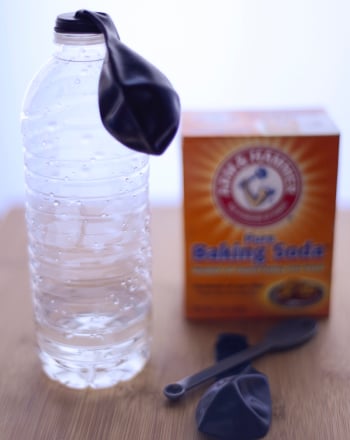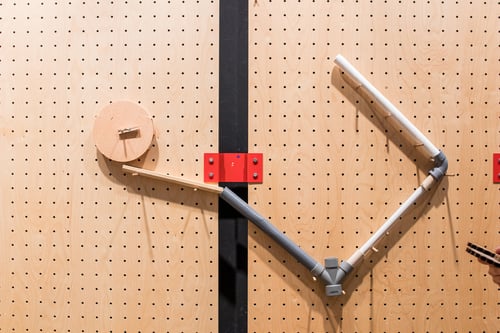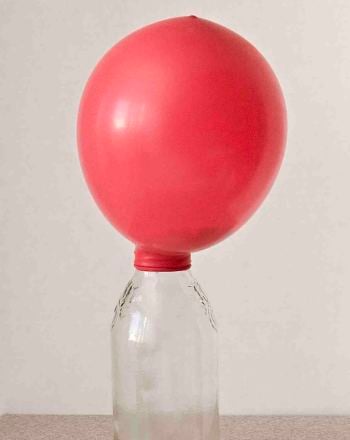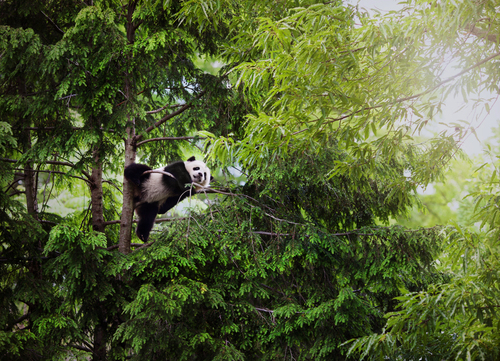Activity
Design Challenge: Inflate a Balloon
In this exciting design challenge, your child will use design thinking skills to create a mixture that can inflate a balloon. Their task is to find which substances will react to inflate a balloon in the shortest amount of time. Your child will likely need to test out a variety of mixtures until they find one that works best. This activity is aligned to the following NGSS standards: 3-5-ETS1-1, 3-5-ETS1-2, 3-5-ETS1-3.
What You Need:
- Balloons
- Empty plastic water bottles
- Stopwatch
- Teaspoon
- Measuring cup
- Pencil and paper for taking notes
- Safety glasses or sunglasses
Kitchen materials to use for this challenge (not all of these will necessarily be successful):
- Sugar
- Baking soda
- Salt
- Mentos
- Vinegar
- Lemon juice
- Water
- Soda
Disclaimer: Do not use any household cleaning products for this experiment. Kitchen materials may react vigorously when combined. Protect your child's eyes with safety glasses or sunglasses during this experiment.
What You Do:
- First, fully explain the design challenge to your child.Explain that their job is to test out the different kitchen materials you're giving them to find a mixture that inflates a balloon in the shortest amount of time. Tell your child that not all of the materials will necessarily work, but they can try different combinations until they find one that does.
- Since the goal of this challenge is to find a mixture that inflates a balloon in the shortest amount of time, your child will need to try several different combinations and compare their effectiveness.
- Ask your child the following questions so that they start thinking about the requirements for inflating a balloon:
- What are some things that you know can inflate a balloon? (Example: helium, your breath)
- Why do you think these sources are able to inflate a balloon? (Answer: Sources that inflate a balloon produce gas.)
- Is there a way that we can make a gas? (Answer: Yes! Chemical reactions can make a gas. Physical changes like heating liquid water until it boils can also make a gas.)
- After your child understands the prompt of this challenge, allow them to begin brainstorming different mixtures that they can create to inflate the balloon. Show them the kitchen materials so they know what they're working with, but don't let them start making anything yet. Make sure that they're taking note of their ideas on a piece of paper so that they can refer back to them later. We recommend that they create their mixtures inside a water bottle and quickly cover it with a balloon to see if it inflates.
- After your child has finished coming up with mixture ideas, ask them to choose the design they think will work best. Have them consider how much of each substance they will use. For example, 1 teaspoon of baking soda and ½ cup of vinegar would be a good starting point for an 8 ounce water bottle. Make sure they are prioritizing the function of the mixture and reiterate its purpose (to inflate the balloon as quickly as possible).
- This is an important step in the design thinking process because it teaches your child to prioritize the effectiveness of their design over their personal preferences.
- Now, your child can begin creating the mixture they chose in the previous step! Give them all the materials and allow them to start mixing.
- Your child should test their mixtures as they create them since the substances may react quickly. After making their mixtures, ask your child to quickly place a balloon over the mouth of the water bottle. You can help out your child by using a stopwatch to observe how long it takes for the balloon to inflate. Then, have your child record on a piece of paper whether or not the mixture successfully inflated the balloon and how long it took to do so.
- In order to reflect, ask your child some of the following questions after creating their first mixture:
- Why do you think this mixture was successful? Or, why do you think the mixture you created didn't work?
- What is something you need to create in order to inflate a balloon? (Answer: gas)
- Do you have any other ideas that you think will work better?
- Regardless of whether or not your child's first mixture was successful, encourage them to repeat this process a few more times. This way, they can compare several different mixtures and determine which one is fastest at inflating a balloon.
- If your child has no success after several attempts and is beginning to feel discouraged, you could encourage them to try mixing baking soda and vinegar. This is a combination that should successfully inflate a balloon.
- Have your child continue repeating this process as long as they'd like, until they create the best mixture they can!
- Extension (optional): Once your child has identified the best mixture to use to inflate the balloon, have them experiment with different quantities of the substances in this mixture to see which combination works best!
Disclaimer and Safety Precautions
Education.com provides the Science Fair Project Ideas for informational purposes only. Education.com does not make any guarantee or representation regarding the Science Fair Project Ideas and is not responsible or liable for any loss or damage, directly or indirectly, caused by your use of such information. By accessing the Science Fair Project Ideas, you waive and renounce any claims against Education.com that arise thereof. In addition, your access to Education.com's website and Science Fair Project Ideas is covered by Education.com's Privacy Policy and site Terms of Use, which include limitations on Education.com's liability.
Warning is hereby given that not all Project Ideas are appropriate for all individuals or in all circumstances. Implementation of any Science Project Idea should be undertaken only in appropriate settings and with appropriate parental or other supervision. Reading and following the safety precautions of all materials used in a project is the sole responsibility of each individual. For further information, consult your state's handbook of Science Safety.
Related learning resources













